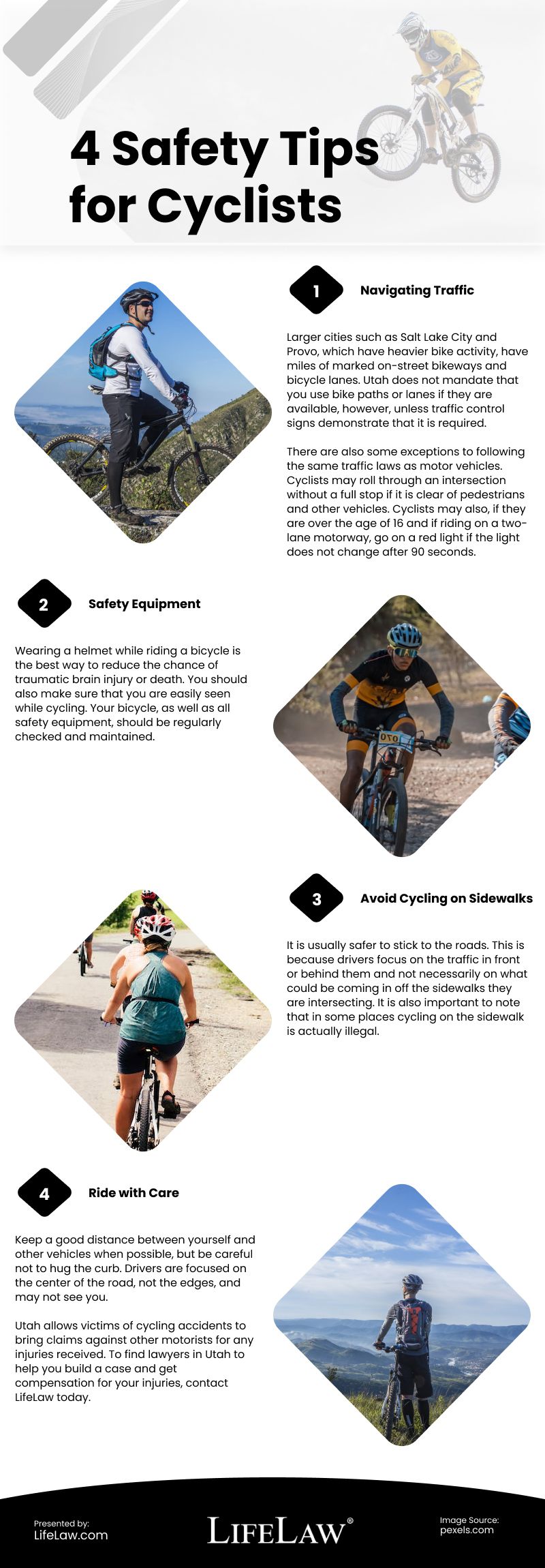Cycling is not only enjoyable and good for your body, it’s an environmentally friendly alternative to cars and other motor vehicles. Unfortunately, it also carries high risks. In the past 10 years, preventable deaths from bike accidents increased 44% according to the National Safety Council. Here in Utah, advocates are calling for more attention to bike safety after a spate of fatal spring biking accidents underscored the dangers of cycling.
The pandemic got more people out on the roads on bicycles, but as the “pandemic cycling boom” continues, it is important to stay up to date with the current safety laws so cars and cyclists can share the road.
Many of Utah’s cities and communities are designed for automobiles, which make them harder to navigate on a bicycle. Bike lanes do exist in some places, but cycling is still a hazardous mode of transportation. Whether you like to ride for recreation or on your daily commute, here are some helpful tips for safer cycling.
Navigating Traffic
In Utah, bikes are considered vehicles, which gives them both the same responsibilities and rights as any other vehicle.
While cycling, always ride with the flow and in the same direction as traffic. Larger cities such as Salt Lake City and Provo, which have heavier bike activity, have miles of marked on-street bikeways and bicycle lanes. Utah does not mandate that you use bike paths or lanes if they are available, however, unless traffic control signs demonstrate that it is required.
There are also some exceptions to following the same traffic laws as motor vehicles. Cyclists may roll through an intersection without a full stop if it is clear of pedestrians and other vehicles. Cyclists may also, if they are over the age of 16 and if riding on a two-lane motorway, go on a red light if the light does not change after 90 seconds. This is to keep traffic moving and to protect cyclist vulnerability while stopping and starting again.
In Utah, cyclists are also protected by a law prohibiting motor vehicle operation within three feet of a moving bicycle. This adds protection during passing.
Safety Equipment
In Utah, it is not required for cyclists to wear a helmet. However, as Utah bike accident attorneys who regularly see tragic results from bike crashes, we recommend that you never get on a bike without wearing a helmet. Wearing a helmet while riding a bicycle is the best way to reduce the chance of traumatic brain injury or death. As with any safety equipment, be sure that your helmet is the right size for you and properly fitted.
You should also make sure that you are easily seen while cycling. Wearing bright-colored clothing and even reflective strips or vests will help people see you. As far as safety equipment attached to your bike, proper lighting is important whether you are typically riding during the day or at night. A white light at the front and red reflectors on the back will make you much more visible to others on the road.
Your bicycle, as well as all safety equipment, should be regularly checked and maintained. In Utah, police officers may request that you submit your bike for inspection if they do not believe it meets basic safety standards.
Avoid Cycling on Sidewalks
Running into heavy motor vehicle traffic may have you contemplating sidewalk cycling. However, it is usually safer to stick to the roads. This is because drivers focus on the traffic in front or behind them and not necessarily on what could be coming in off the sidewalks they are intersecting.
It is also important to note that in some places cycling on the sidewalk is actually illegal. However, in faster, higher traffic areas with no shoulder and multiple lanes the sidewalk may turn out to be the only option. If this is the case, proceed with extra caution.
Ride with Care
Even with laws in place to protect cyclists, cycling remains a dangerous activity. However, riding conscientiously and observantly can help keep you safe from serious harm.
Keep a good distance between yourself and other vehicles when possible, but be careful not to hug the curb. Drivers are focused on the center of the road, not the edges, and may not see you. The curb or edge of the road also has more debris, gravel, and cracked pavement which could cause you to lose control of your bicycle.
As we hope that motor vehicle drivers are being vigilant when sharing the road with cyclists, cyclists must also pay close attention to drivers. It’s good practice to make eye contact and give clear signals to drivers of the vehicles near you to communicate your intentions when turning, slowing or stopping. Many cycling accidents occur at intersections, so when stopping and starting, extra caution is a must. Also, in case of any miscommunication, always be ready to brake.
Utah allows victims of cycling accidents to bring claims against other motorists for any injuries received. To find lawyers in Utah to help you build a case and get compensation for your injuries, contact LifeLaw today.
Infographic
Cycling is an enjoyable and healthy activity that is also eco-friendly. However, it comes with high risks, as preventable deaths from bike accidents have increased by 44% in the past decade, according to the National Safety Council. Whether you cycle for fun or as part of your daily commute, check out this infographic for valuable tips to help you cycle safely.

